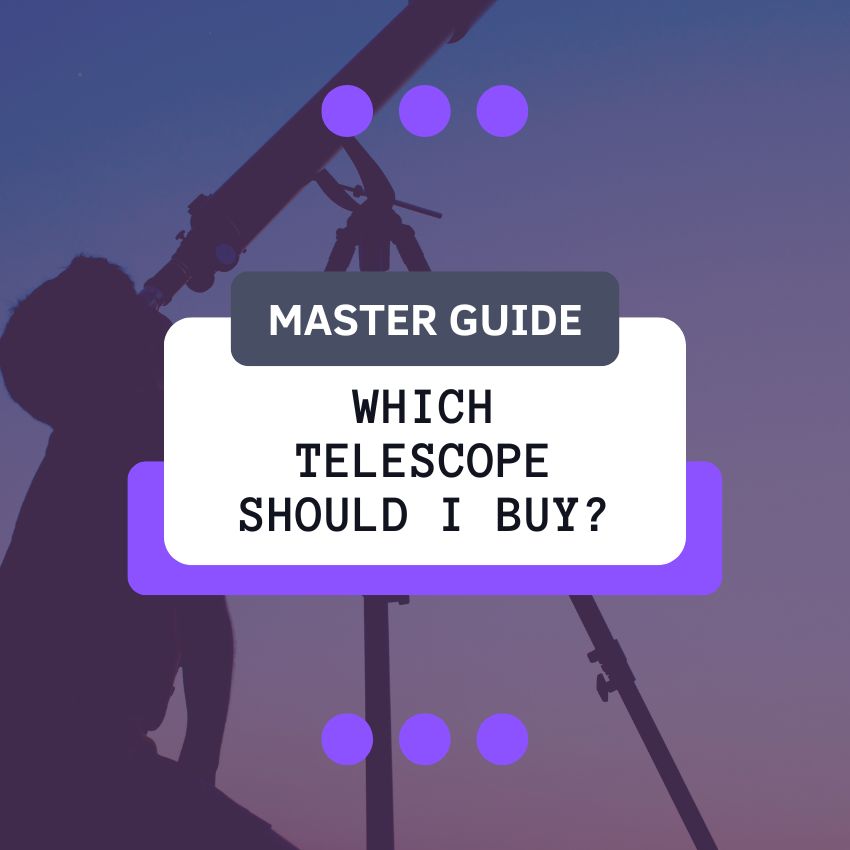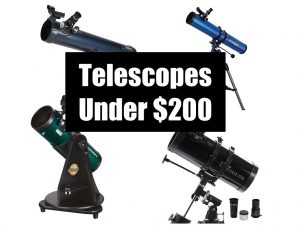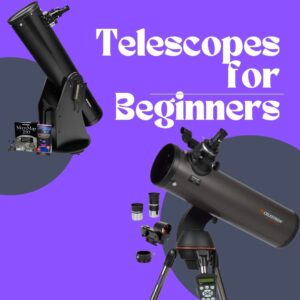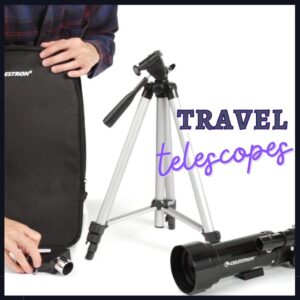This site contains affiliate links to products. I may receive a commission for purchases made through these links.
The best telescope for you depends on your observation goals. For example, Celestron NexStar 8SE is great for deep-sky observation, Meade LX65 Maksutov-Cassegrain is great for wide-view observation, and Celestron Advanced VX 8-inch Edge HD is excellent for astrophotography.
| Use Case | Telescope Model and Brand |
|---|---|
| For Beginners | 1. Celestron NexStar 8 SE Computerized Telescope |
| 2. Orion SkyQuest XT8 | |
| 3. Zhumell Z100 Altazimuth Reflector Telescope | |
| 4. Celestron StarSense Explorer LT 80AZ Smartphone Telescope | |
| 5. Sky Watcher Classic 250 Dobsonian 8-inch Aperture Telescope | |
| 6. Celestron – 70mm Travel Scope | |
| Deep Space Observation | 1. Orion SkyQuest XT8 Classic Dobsonian Telescope |
| 2. Sky-Watcher USA 10″ Classical Dobsonian (S11620) | |
| 3. Apertura AD8 Dobsonian | |
| 4. Celestron NexStar 8SE | |
| Astrophotography | 1. Sky-Watcher Esprit 100 |
| 2. Unistellar eVscope eQuinox 114mm f/4 GoTo Reflector Telescope | |
| 3. Celestron 31045 AstroMaster 130EQ Reflector Telescope | |
| 4. Sky-Watcher EvoStar 80 APO Doublet Refractor | |
| 5. PlaneWave 14-Inch CDK f/7.2 OTA Telescope with Fused Silica Optics | |
| Professional Astronomers | 1. Gskyer 130EQ |
| 2. Telescope 130EQ Newtonian Reflector | |
| 3. Celestron NexStar 8SE Telescope |
The telescopes listed cover a range of price points and features, catering to different levels of expertise and interests within astronomy. Some models are suitable for multiple categories, like the Celestron NexStar 8SE which is good for both beginners and deep space observation. For professional astronomers, telescopes like the Gskyer 130EQ and the Telescope 130EQ Newtonian Reflector are highlighted.
This guide will show you which telescope you should buy. It’ll explain the different types of telescopes, telescopes suitable for specific observation needs, and more.
Let’s get started!
Important considerations
- Understanding Your Interests:
- Astronomical Interests: Determine what celestial objects you are most interested in observing. Different telescopes are suited for different purposes, such as planetary viewing, deep-sky observations, or astrophotography.
- Educational or Professional Use: Determine whether the telescope will be used for educational, recreational, or professional purposes as different scopes cater to different levels of expertise and usage.
- Budget:
- Telescopes come in a wide range of prices. It’s important to set a budget and find a telescope that fits within it while meeting your needs.
- Type of Telescope:
- Refractor Telescopes: Use lenses to gather light and are good for viewing the moon, planets, and stars.
- Reflector Telescopes: Use mirrors, and are suited for viewing celestial objects like star clusters and galaxies.
- Catadioptric Telescopes (Compound): Use both lenses and mirrors, and are versatile for viewing different celestial objects.
- Aperture Size:
- The aperture size, or diameter of the telescope’s main optical component, is crucial as it determines how much light the telescope can gather, affecting the brightness and clarity of the images.
- Mount Type:
- Altazimuth Mount: Simpler and good for beginners.
- Equatorial Mount: More complex but allows for smooth tracking of celestial objects as they move across the sky.
- Portability and Storage:
- Consider the size and weight of the telescope, especially if you plan to transport it frequently for stargazing in different locations.
- Accessories:
- Consider the cost and availability of accessories like eyepieces, filters, and mounts which can enhance your viewing experience.
- Maintenance:
- Some telescopes require more maintenance than others, like keeping mirrors aligned (collimation) in reflector telescopes.
- Brand Reputation and Reviews:
- Look for reputable brands and read reviews from other users to get a sense of the telescope’s performance and quality.
- Local Astronomy Clubs and Observatories:
- Joining a local astronomy club or visiting observatories can provide hands-on experience and advice from seasoned astronomers regarding which telescope to purchase.
- Educational Resources:
- Seek out books, online courses, and tutorials to learn more about astronomy and how to use a telescope.
- Warranty and Customer Support:
- Check for warranty information and the level of customer support provided by the manufacturer.
By considering these factors and gathering the necessary information, prospective telescope buyers can make a more educated decision that aligns with their interests, level of expertise, and budget.
Types of telescopes
There are different types of telescopes for observing and exploring deep-sky objects. These include:
- Refractor telescopes
- Reflector telescopes
- Schmidt-Cassegrain telescopes
- Maksutov-Cassegrain telescopes
- Smart telescopes
Read also: Types of Telescopes & Their Uses (w/ Expert Recommendations)
Refractor telescopes
A refracting telescope (or refractor) uses a lens as its objective to form an image. It’s essentially a long tube with a lens at the front and an eyepiece at the rear.
One of the best-selling refractor telescopes is Celestron StarSense Explorer DX 102AZ.

A top-selling refractor for low-budget astronomers is the Hexeum 80mm aperture refractor.
Reflector telescopes
A reflector (or reflecting telescope) uses a curved mirror (or a combination of mirrors) that reflects light to form an image. The telescope is a tube with an open front and a curved mirror at the bottom.
Because their relatively larger apertures allow reflector telescopes to gather more light, they are excellent for observing distant objects that appear faint. However, with bigger apertures, reflectors can be bulky. Also, their mirrors require occasional alignment.
One of the best-selling reflector telescopes for beginner astronomers is the Celestron AstroMaster 130EQ Newtonian telescope.
You may also like: Refractor vs Reflector Telescope: What Is The Difference?

Schmidt-Cassegrain telescopes
The Schmidt-Cassegrain telescope (SCT) is a compound telescope that uses a lens and mirrors to create an image. The scope’s design folds a long optical path, making for a short, stubby tube.
SCTs are good at everything. Their design allows for larger apertures, making them excellent for viewing faint deep-sky objects. The SCTs are easy to mount and guide. They are also suitable for narrow-field and wide-field imaging, making them perfect for astrophotography.

Celestron Nexstar 6SE 150mm f/10 Schmidt-Cassegrain GoTo Telescope
Maksutov-Cassegrain telescope
A Maksutov-Cassegrain telescope (Mak) is the second most popular Cassegrain telescope (after the Schmidt-Cassegrain telescope). A Mak is a compound telescope (or catadioptric telescope) that uses both lenses and mirrors to form images.
A cost-effective Maksutov-Cassegrain Telescope suitable for kids and adults is the portable Sarblue Mak60 Telescope, which comes with an Adjustable Tripod, Finderscope, and phone adapter.

Dobsonian telescopes
A Dobsonian telescope is a reflector mounted on a modified alt-azimuth mount that rotates and pivots up and down, allowing you to locate targets easily.
Dobsonian telescopes have large apertures, making them suitable for viewing faint objects. They are perfect for visual astronomy but are not well-suited for astrophotography.
Dobs are very easy to use, making them perfect for amateur astronomers. However, being reflectors, their mirrors need constant adjusting. They can also be heavy and more difficult to transport (especially when seeking darker areas with less light pollution).
A cost-effective Dobsonian telescope for beginners is the Celestron 76mm Cometron FirstScope.
With a bigger budget, you can get the powerful Sky-Watcher Classic 150 Dobsonian, which delivers exceptional views.

Sky-Watcher Classic 150 Dobsonian
Smart telescopes
Smart telescopes are digital telescopes controlled from a smartphone or tablet. They use software, an integrated image sensor, and optics to deliver a unique experience.
One of the most popular Smart Telescopes in the market is the Unistellar eVscope eQuinox Smart Digital Reflector telescope. Its versatility makes it suitable for astronomers of all ages (kids and adults) and skill levels (beginners and advanced).
You may also like: Unistellar eVscope Review

The best telescopes for different observing goals
The best telescope for you depends on your observing goals. While some are best suited for deep-sky observation, others excel in astrophotography.
Best telescopes for deep-sky observation
Deep-sky objects that lie beyond our solar system (such as distant galaxies, nebulae, and star clusters) are favorite targets of amateur astronomers.
Some of the best telescopes for observing these astronomical objects include:
- Celestron NexStar 8SE
- Meade LX90-ACF
- Orion SkyQuest XT8 Classic Dobsonian
- Sky-Watcher ProED 100mm Doublet APO Refractor
- William Optics ZenitStar 61 APO Refractor
Celestron NexStar 8SE
Celestron NexStar 8SE is a computerized Schmidt-Cassegrain telescope with an 8 inches primary mirror.

Celestron Nexstar 8SE Specifications:
- Optical design: Schmidt-Cassegrain
- Aperture: 8 inches (203 mm)
- Focal length: 80 inches (2032 mm)
- Mount: computerized altazimuth fork arm
- Weight: 24 lbs (10.88 kg)
The Celestron NexStar 8SE telescope delivers one of the best experiences for beginners and advanced stargazers.
The telescope features an 8-inch aperture, giving it excellent light-gathering ability. This allows the scope to give sharp images across the entire field of view. It provides breathtaking images whether you’re observing objects in our solar systems or those far beyond it, including star clusters and other deep-sky objects.
You only need to center any three bright objects in the eyepiece, and the scope will align to the night sky. With its fully-automated Go-To mount, the Celestron Nexstar 8SE will automatically locate and track objects for you.
The telescope is compact, making it ideal for quick travels to dark-sky sites. The telescope comes with accessories that include a red dot finder, a 25mm Plossl eyepiece, a visual black metal adapter, and a star diagonal.
While it comes at a high price, it is a high-quality telescope that represents good value for money.
Meade LX90-ACF
Meade LX90 ACF is a high-resolution Advanced Coma-Free telescope featuring a 12-inch aperture, 120-inch focal length, and dual-fork mounting.

Meade LX90 ACF Specifications:
- Optical design: Advanced Coma-Free
- Aperture: 12 inches (305 mm)
- Focal length: 120 inches (3,048 mm)
- Mount: Double fork
- Weight: 57 lbs (25 kg)
Meade LX90 ACF is suited for visual astronomy and more advanced areas of astronomy, such as long-exposure astrophotography.
As its name suggests, the 12-inch telescope uses the patented Meade Advanced Coma-Free (ACF) optical design. Think of it as a Schmidt-Cassegrain telescope with a slightly different corrector to remove the coma.
The telescope also has Ultra-High Transmission Coatings (UHTC) that improve its optics. Thus, it gives high-quality optics. When observing deep-sky objects, you’ll see more fine detail in nebulae, brighter star clusters, etc.
The LX90 telescope models are easy to operate. You won’t stress reading star charts to align the telescope manually. Using an incorporated 16-channel Sony GPS receiver, star alignment is done quickly. The telescope uses Meade’s AudioStar computer system with a 30,000+ object database to automatically locate and track objects for you.
Thanks to AudioStar, Meade LX90 ACF telescope also serves educational functions. Using an in-built speaker, it can provide you with professionally-recorded audio descriptions of the objects you are observing.
Orion SkyQuest XT8 Classic Dobsonian
Orion SkyQuest XT8 Classic Dobsonian is an 8-inch aperture, 47-inch (1200 mm) focal length Dob telescope that combines high-quality optics with the ultimate in mechanical simplicity and stability.

Orion SkyQuest XT8 Classic Dobsonian Specifications:
- Optical design: Reflector
- Aperture: 8 inches (203 mm)
- Focal length: 47 inches (1,200 mm)
- Mount: Dobsonian
- Weight (fully assembled): 41 lbs (18.5 kg)
The Orion SkyQuest XT8 Classic Dobsonian is an excellent beginner telescope suited for deep sky observation. With an 8 inches aperture and 0.57 arc sec resolving power, this Orion is a powerful telescope model that provides great views of distant galaxies, sparkling new clusters, and cloudy nebulas.
The Dobsonian mount keeps the scope perfectly balanced for easy point-and-view use, making this Orion telescope ideal for beginner astronomers.
The package includes accessories like a 2” Crayford focuser, a 25mm Sirius Plossl eyepiece, an Orion EZ Finder II red-dot finder, a collimation cap, Starry Night software, and a smartphone adapter.
This Orion Dob is a good option if you want a budget telescope that provides powerful optics. However, it’s on the heavy side.
Sky-Watcher EvoStar ProEd 100 APO Doublet Refractor
The Sky-Watcher EvoStar 100 APO Doublet Refractor is a 100 mm (4 inches) optical tube that offers premium optical performance for amateur astronomers.

Sky-Watcher EvoStar 100 APO Doublet Refractor Specifications:
- Optical design: Refractor
- Aperture: 4 inches (100 mm)
- Focal length: 35.4 inches (900 mm)
- Weight: 8.4 lbs (3.8 kg)
Thanks to a matched doublet objective and the proprietary Metallic High-Transmission Coatings (HMTC), EvoStar refractors produce sharp images with minimal aberrations.
The telescope provides super contrast and high-definition resolution for visual astronomy of deep-sky objects.
While the Sky-Watcher EvoStar 100 APO Doublet refractor is an excellent first telescope, the scope is versatile enough to use as your skill set improves.
This Sky-Watcher EvoStar telescope is also easy to handle. The scope is lightweight, meaning you can easily carry it anywhere and use a less beefy (thus less expensive) mount.
The scope comes with a Crayford-style focuser, two dielectric diagonals, two 1.25 LE eyepieces, a dovetail and rings for mounting, etc.
William Optics ZenitStar 61 APO Refractor
The ZenithStar 61APO Refractor from William Optics is an incredibly portable 61mm refracting telescope suitable for beginners and veterans.
William Optics ZenithStar 61 APO Refractor Specifications:
- Optical design: Refractor
- Aperture: 2.4 inches (61 mm)
- Focal length: 14 inches (360 mm)
- Weight: 3.2 lbs (1.45 kg)
The Zenithstar 61 APO refractor is a two-element designed APO refracting telescope. The Zenithstar 61 APO refractor uses high-quality (FPL-53) glass, ensuring aberration correction. Thus, the telescope gives crisp images.
With a focal length of 360 mm, this Zenithstar is tiny in size. However, it comes with a standard 2” R&P focuser with a 10:1 micro adjustment (a rarity for tiny telescopes). The focuser is stable and reliable, so there’ll be no image shifting when using the scope.
Given its tiny size, the Zenithstar 61 APO refractor is also lightweight. It’s one of the best beginner telescopes you’ll find. However, its versatility makes it suited for both beginners and advanced stargazers. Lastly, it’s a good budget telescope.
You may also like: What Telescope Size Do I Need to See Galaxies?
Best telescopes for wide-field observation
When observing celestial objects, you don’t have only magnification or quality optics to think of. You also have to consider the field of view (specifically getting a wide field). This is because your telescope’s field of view determines how much of the sky you’ll see.
Some of the best telescopes for wide-field observation include:
- Celestron NexStar Evolution 8
- Meade LX65 Maksutov-Cassegrain
- Sky-Watcher Evostar 72 ED DS Pro
- William Optics ZenithStar 73 APO Refractor
Celestron NexStar Evolution 8
Celestron NexStar Evolution 8 WiFi Enabled telescope is an 8-inch Schmidt-Cassegrain computerized telescope with WiFi functionality.

Celestron NexStar Evolution 8 Specifications:
- Optical design: Refractor
- Aperture: 8 inches (203.2 mm)
- Focal length: 80 inches (2032 mm)
- Mount: Altazimuth
- Weight: 38.49 lbs (17.45 kg)
The NexStar Evolution 8 telescope features a compact 8” optical tube with StarBright XLT optical coating. These allow it to give stunning images covering a wide field of view.
The Celestron NexStar Evolution is designed to be the most user-friendly computerized telescope. Using Celestron’s proprietary SkyAlign, you’ll align the scope to the night sky and be ready for stargazing in minutes.
From there, viewing is easy. You can select a target from the app’s database, and the telescope locates and tracks it automatically. If you’re undecided, the app offers a curated list of objects to view (Tonight’s Best Objects).
The scope comes with a computerized GoTo mount that effortlessly tracks objects as they appear to drift across the night sky. A powerful 10-hour LiFePO4 battery powers the electronic telescope.
The telescope comes with a StarPointer red dot finder, a star diagonal, two 1.25” Plossl eyepieces, and an AC adapter.
Meade LX65 Maksutov-Cassegrain
The Meade LX65 Maksutov-Cassegrain telescope is a 6-inch catadioptric OTA for mid-level use for high-resolution wide-field deep-sky use.
Meade LX65 Maksutov-Cassegrain OTA Specification:
- Optical design: Maksutov-Cassegrain
- Aperture: 6 inches (150 mm)
- Focal length: 70 inches (1800 mm)
- Mount: Compatible with Altazimuth, equatorial, and GoTo mounts
- Weight (OTA only): 12.7 lbs (5.76 kg)
The Meade LX65 Maksutov-Cassegrain is designed as a mid-level optical tube assembly (OTA) for those who need to upgrade their OTA. The LX65 can reach outside the solar system and resolve to objects.
The instrument’s Maksutov-Cassegrain design is complemented by Meade’s UHTC (Ultra-High Transmission Coatings) system to correct spherical and chromatic aberrations and comas. Thus, the OTA produces high-resolution views with sharp contrast and true color rendition.
The LX65 comes with a 1.25” 26mm focal length eyepiece for wide-field observation. It also comes with a finder ensuring a wide field view for easier alignment and object locating.
Sky-Watcher Evostar 72 ED DS Pro
The Sky-Watcher EvoStar 72ED DS Pro is a refracting telescope with a 72 mm (2.8 inches) aperture.

Sky-Watcher EvoStar 72ED DS Pro Specifications:
- Optical design: Refractor
- Aperture: 2.8 inches (72 mm)
- Focal length: 16.5 inches (420 mm)
- Mount:
- Weight (OTA only): 4.3 lbs (1.95 kg)
The Sky-Watcher Evostar 72ED D refractor telescope features a matched doublet objective lens with fluorite elements. Complementing this is Sky-Watcher’s proprietary Metallic High Transmission Coatings (MHTC). These provide excellent color correction., ensuring sharp images with accurate color.
Besides the optical quality, another big selling point of this Sky-watcher telescope is its portability. Its compact and lightweight design makes this refractor the perfect travel companion.
It’s the perfect first telescope, and there’s no need to replace it as your skill set evolves. It is ideal for beginner and seasoned astrophotographers alike.
With a 10:1 dual-speed focuser, finding a focus for wide-field observation will be a breeze no matter the eyepiece you use. The telescope comes with everything you need, including an aluminum case, tube rings, and dovetail.
William Optics ZenithStar 73 APO Refractor
William Optics Zenithstar 73 APO Refractor is a portable apochromatic doublet telescope built for astrophotography.
William Optics Zenithstar 73 APO Refractor Specifications:
- Optical design: Refractor
- Aperture: 2.87 inches (73 mm)
- Focal length: 17 inches (430 mm)
- Mount:
- Weight (OTA only): 6.24 lbs (2.83 kg)
The Zenithstar 73mm APO refractor is a portable telescope built for astrophotography. The telescope uses premium glass that provides excellent aberration correction.
In addition, the 73 APO refractor comes with a 2.5” focuser. It’s excellent for sharp, wide-field deep-sky observation. The scope comes with T-Ring mounts to easily attach your scope to a Canon EF, Nikon F, Pentax, Fuji FX, or Sony E.
The Zenithstar 73 APO refractor comes in a range of fancy colors, allowing you to get a scope that matches your colorful personality. It’s also portable and lightweight, making it easy to handle and operate.
You may also like: Best Telescopes for Home Use (Read this first!)
Best telescopes for astrophotography
For photography of astronomical objects, you need powerful telescopes to track objects’ movement in the night sky. Some of the best telescopes for astrophotography include:
- Celestron Advanced VX 8-inch EdgeHD
- Meade LX200- ACF
- William Optics ZenithStar 103 APO refractor
Celestron Advanced VX 8-inch EdgeHD
Celestron Advanced VX 8-inch EdgeHD is an advanced telescope that combines Celestron’s best optics with the AVX mount that provides superior tracking performance.

Celestron Advanced VX 8-inch EdgeHD Specifications:
- Optical design: Schmidt-Cassegrain
- Aperture: 8 inches (203.2 mm)
- Focal length: 80 inches (2032 mm)
- Mount: Computerized equatorial mount
- Weight: 85.5 lbs (38.8 kg)
Celestron Advanced VX 8-inch EdgeHD is an optically excellent telescope.
The EdgeHD optical system is an improved Schmidt-Cassegrain, involving additional lens elements that make it more suited for astrophotography. So, EdgeHD outperforms classic Schmidt-Cassegrain telescopes.
The Advanced VX 8-inch EdgeHD comes with one of the most advanced astronomy software, and you can select objects using the hand controller. Thus, the scope will identify objects in the sky and track them reliably.
The telescope comes with the Advanced VX mount, which is Celestron’s smallest German equatorial mount. The computerized GoTo capability enables the scope to track objects automatically as they move across the sky.
Meade LX200-ACF
Meade LX200 ACF is a powerful 12-inch telescope with a focal length of 120 inches and dual-fork mounting.
Meade LX200 ACF Specifications:
- Optical design: Advanced Coma-Free (ACF)
- Aperture: 12 inches (305 mm)
- Focal length: 120 inches (3048 mm)
- Mount: Fork arm altazimuth mount
- Weight (fully assembled): 133 lbs (60.3 kg)
The Meade LX200 boasts a 12-inch aperture and a resolving power of 0.380 arc seconds. It’s also equipped with Ultra High Transmission Coatings (UHTC). These allow the telescope to give crisp images.
This model uses Meade’s level north technology alignment system and a 16-channel GPS receiver, allowing near-effortless star alignment.
Meade LX200 comes with a DC-servo-driven dual fork mount that automatically guides the telescope during astrophotography. The LX200 is one of the most widely used portable research-grade telescopes.
William Optics ZenithStar 103 APO Refractor
William Optics ZenithStar 103 APO Refractor is a compact and solid scope perfect for serious observation of deep sky objects.
William Optics ZenithStar 103APO Refractor Specifications:
- Optical design: Refractor
- Aperture: 4 inches (103 mm)
- Focal length: 30 inches (710 mm)
- Mount:
- Weight (tube only): 9.7 lbs (4.4 kg)
The ZenithStar 103APO Refractor is everything you want in a refracting telescope for astrophotography.
It is a double-air-spaced APO featuring an ultra-high precision lens cell. The telescope provides sharp images, showing clear details and true colors.
The telescope also has a 2.5” R&P focuser with 10:1 dual speed. The focuser ensures no image shifting during astrophotography.
The ZenithStar is also a beautiful telescope, available in bold colors. Like all ZenithStar telescope models, you can easily attach our Canon EF, Nikon F, or Sony E to the scope.
Learn more about the best telescopes for astrophotography here.
Is a case included in a telescope purchase?
Most telescopes come with hard cases. Some come with soft cases, while a few come with no case at all except the original bulky packaging.
However, a hard case is a necessity for telescopes. It keeps your scope safe in transit (to darker sky sites) and during storage. Thankfully, you can purchase sturdy hard cases for your telescope separately.
An example is this Celestron 40” Telescope Storage and Carrying Bag.

Is a telescope a good gift idea?
A telescope symbolizes curiosity, enthusiasm, intellect, and a scientific mind. So, it is an outstanding gift for anyone with a curious mind. A telescope can be the best gift if the would-be recipient has a passion for science, particularly the heavens.
Even if people have yet to express interest in the heavens, a telescope would still be a great gift to invite them to join the exciting world of observing the sky and becoming aware of the fascinating worlds out there.
A telescope is a popular gift idea for birthdays, Christmas, anniversaries, and graduations. You’ll find telescopes suitable for different age groups and stargazing skill levels.
Check out more astronomy gift ideas in this article.
Takeaway – Get a telescope and see the fascinating worlds in the sky
A telescope will open up the fascinating worlds in the sky to you. There are different types of telescopes. These are refractors, reflectors, compound telescopes (Schmidt-Cassegrain and Maksutov-Cassegrain telescopes), Dobsonian telescopes, and smart telescopes.
Factors to consider when choosing a telescope include aperture size, magnification, focal length, eyepiece, mount, and price. However, the best telescope for you will depend on your observation goals.
For example, Celestron NexStar 8SE is an excellent option for deep-sky observation, MeadeLX65 Maksutov-Cassegrain is a great option for wide-view observation, and Celestron Advanced VX 8-inch Edge HD is an excellent option for astrophotography.




